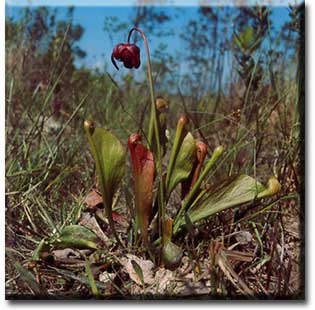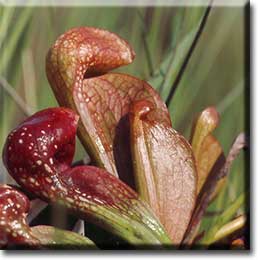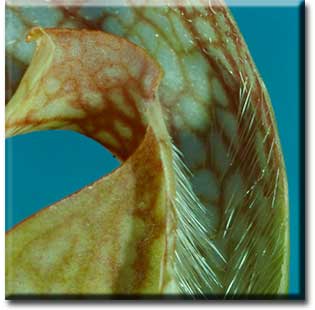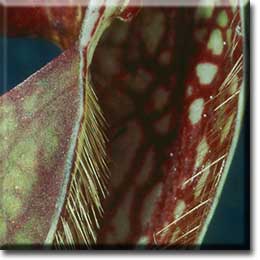Sarracenia psittacinaCarnivorous Plants / Insectivorous Plants
Sarracenia psittacina, the parrot pitcher plant, is found in boggy low-lying areas of pine forests from Georgia to Louisiana. In the background of this picture, we se the standing water of a bog.
Here we see a typical plant of Sarracenia psittacina, with pine trees in the background. The leaves are like narrow tubes, with a prominent wing on the side facing the center of the plant. Leaves of the parrot pitcher plant from old (left) to young (right). The leaf, when mature, has a balloon-like hood. In a mature leaf, there is a mouth-like opening in this hood. The younger leaves show that the wing develops early, but the hood increases in size later, as the leaf matures. The younger leaves cannot trap insects, therefore. A mature leaf of Sarracenia psittacina often has a conspicuously red-purple hood, with the tubular part of the leaf greener closer to the ground. The opening of the hood faces downward. Here's what an insect sees from below the hood: an opening edged with bright red--an opening that offers tiny drops of nectar.
Not all leaves of the parrot pitcher plant are bright red-purple. This one is somewhat greener and shows the mouth of the hood close to the top of the wing. The veining on the hood is purple, but there is also green, and--more importantly--numerous patches that are translucent, transmitting the sunlight into the interior of the hood. If an insect flies into the hood, it tends to respond by seeing these "window-like" patches as like the sky, and therefore tends to fly upward instead of downward and out of the hood. A close-up of the transition from the tube to the hood of a leaf of Sarracenia psittacina. Notice the "window-like" patches that appear white and fool insects into flying toward them instead of out of the mouth of the hood. The California pitcher plant, Darlingtonia, uses the same device to capture insects. A section down through the hood of a pitcher shows the wonderful trap. You can see the mouth into which an insect might fly, and then, the window-like areas above it that fool the insect into thinking that it is flying toward the sky. An insect often tires before finding the opening and attempts to crawl out. Not a good idea for it! The insect crawls down into the tube. But the really large, spike-like hairs point downwards, so that it can crawl downward easily, but not upward....  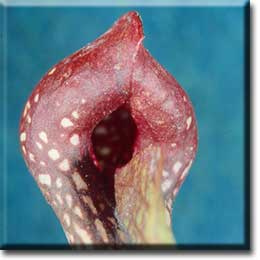 
The downwardly-pointing hairs are dense (not all show in this picture). The tubular part of the pitcher gets narrower as the insect crawls downward. This means that if it tries to fly upward in the narrow tube, it is more and more likely to hit the side, rather that get back up into the hood. And so the hairs keep pointing it farther and farther down, to the pool of liquid at the bottom, where it drowns. An open flower of the parrot pitcher plant, placed together with a young leaf. The flowers open downward. This flower has been re-arranged, therefore, so that you can see how it would look if an insect saw it from below. Very likely, an insect would be attracted by the big white center area (the back side of the stigma) surrounded by the red-purple petals. There is white, which an insect would tend to follow, at the base of each petal. A section down through a flower--arranged as the flower is in nature, facing downward. To get in, an insect has to crawl around the down-turning edge of the stigma, which it does by pushing back the re-curving portion of the petal (white zigzag part of the petal, at right). This trap-like mechanism tends to keep it inside the flower for a longer time, to increase the chances that it will pick up the pollen grains from the stamens (yellow) or deposit some of the pollen grains on the umbrella-shaped stigma. The Exyra moth lives inside the pitchers of Sarracenia but doesn't get caught. This Exyra mouth is just below the circular mouth of the hood. Below the black hood of the moth, on the wing, one can se some shiny surfaces. The shininess is nectar, a food source that lures insects other than the Exyra moth to the mouth area of the hood, where they tend to enter the hood because there is more nectar around the edge of the mouth. 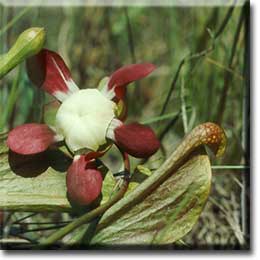 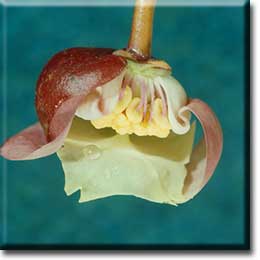 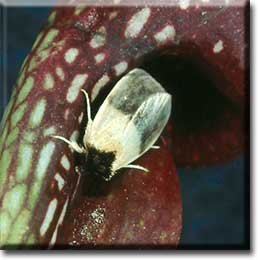 |

